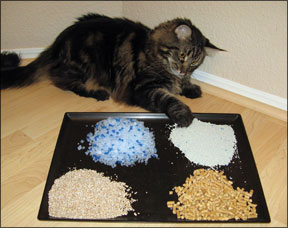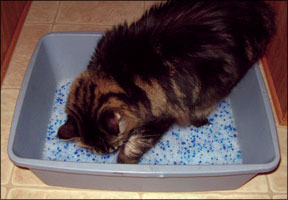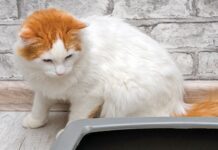Within the past several years, a number of products have entered the cat litter market as “alternative” litters. The chief claim of many of these litters is that they are made from plant-based or Bev Caldwell 288 recycled materials, as opposed to clay, the basis of “traditional” kitty litters. Potential Benefits of New Litters
As with most products or groups of products, there are both advantages and disadvantages to using alternative cat litters. One advantage that makers of these specialty litters feel appeals to cat owners with environmental concerns is that alternative litters – because they are made of biodegradable substances – present less strain on landfills. Some brands are even marketed as being “compostable” and/or burnable.
Additionally, alternative litters are often give off little or no dust, which could be a benefit to a cat with upper-respiratory issues. “Our general advice to owners of asthmatic cats is to limit environmental exposure to potential irritants of all kinds,” says Carolyn McDaniel, VMD, a consultant with the Cornell Feline Health Center. “This includes aerosol cleaning agents, perfumes, cigarette smoke … and dusty cat litter.”
Another benefit of some alternative cat litters is the lack of artificial fragrances or harsh chemical additives. Dyes and deodorizers found in some cat litters have been linked with contact allergies in cats, says Dr. McDaniel, noting that even though allergic dermatitis is fairly common in the cat and it can be difficult to sort out a cause, “Any cat with dermatitis lesions affecting the paws should have the litter type evaluated for possible allergies.”
Any Drawbacks?
One of the biggest potential downsides to using an alternative kitty litter involves owner convenience: Not all of them are clumpable or scoopable. Clumpable/scoopable clay litters first appeared on the market in the 1980s and have remained a popular choice among cat owners. In fact, 70 percent of cat litters purchased are clumpable and scoopable, according to the American Pet Product Manufacturers Associations 2007/2008 National Pet Owners Survey.
Cat litters that dont clump must be emptied and replaced more often to keep odors under control. The inability to scoop urine clumps from certain alternative litters may mean that owners will have to change the litter more frequently to avoid undesirable odors (and could incur a higher cost by simply using more litter, more often).
And, finally, theres a potential “tactile” issue with alternative cat litters. The reason alternative litters are “low-dust” is that their textures are often courser than a traditional clay litter; many alternative litters are in pellet form. “Cats are sensitive to all kinds of sensory input,” notes Dr. McDaniel. “Although individuals vary, cats in general seem to prefer soft, fine, sandy material in their boxes.” So some cats may not like the rougher texture of certain alternative litters.
Where to Start?
New litters are appearing on (and disappearing from) the cat market on a regular basis. Some varieties are offered through national pet store chains, while others are available regionally or through Web-based companies. The following is a current list of types of alternative litters, categorized by their primary ingredients, and some product information as provided by manufacturers.
Wood-Based Kitty Litters
Of the alternative kitty litters appearing on the market, the APPMAs study shows that those made from wood pulp or shavings are the most popular – five percent of all litters purchased were made from pine or other chips. According to the manufacturers, pine-based varieties are made from recycled shavings, which are kiln dried to remove aromatic oils, and then compressed into

Bev Caldwell
288
pellets. Feces can be scooped out, while urine is absorbed by the pellets, which swell on contact. Moistened pellets then dissolve into a wet wood dust. (One product, Feline Pine Scoop Cat Litter creates clumps by adding guar bean to the pine pellets.)
Available products include: Feline Pine Cat Litter, Lone Star Pine Pellets, Luv My Kitty Kitty Litter, Pestell Pine Cat Litter, Exquisicat Pine Cat Litter, Flint River Ranch Cat & Kitten Litter, Healthy Pet Cracked Pine Cat Litter, and Natures Logic Ponderosa Pine Litter. Another product, Cedarific Cat Litter, is not in a pellet form; rather, it is a blend of hardwood and cedar chips.
Grain-Based Kitty Litters
These litters are made primarily from wheat, oats or corn. According to manufacturers, odors are eliminated by “natural enzymes” contained in the grains. And, if your cat ingests these products, manufacturers say the litter will pass safely through the cats system.
Other benefits of these grain-based kitty litters are that they are clumpable, and some are flushable. (Note: A 2006 California law recommends disposing of cat litter in landfills rather than flushing it, in order to limit contamination of sea-otter habitat with harmful Toxoplasma gondii.)
Wheat-based litters include: SwheatScoop Natural Wheat Litter (available in retail stores), and WheatnEasy (available through veterinarians only).
Corn-based litters include: Worlds Best Cat Litter, Clump n Flush Cat Litter, Natures Miracle Odor Control Clumping Cat Litter, Littermaid Cat Litter and Vetbasis Nature Derived Herbal Cat Litter.
Other grain-based litters include: Healthy Pet Milled Grain (made from grain by-products) and Healthy Pet Health Plus, which contains grain by-products and reclaimed paper).
Other Plant-Based Litters
In addition to pine- and grain-based litters, the alternative litter market also contains a few products made from some rather unusual substances. Healthy Pet P-Pod Clumping Cat Litter is made from dried ground pea pods. One Earth Cat Litter is made from yucca, pine, corn cob granules and “natural fragrances.” And Cat Country Organic Wheatgrass Litter for Cats is made from winter wheatgrass fibers.
Paper-Based Litters
Kitty litters made from recycled paper come in both pellet and granule forms. Recycled paper products tend not to cling to cats’ paws, making them a popular choice for kittens, recently declawed cats and other post-operative care, say manufacturers. Many of the products also claim to be safe to incinerate, compost and flush with septic systems.
Paper-based litters include: PaPurr Paper Scoop Cat Litter (granules), Good Mews Cat Litter (pellets), Purina Yesterdays News (pellets), Kitty Soft Paper Cat Litter (pellets with baking soda), and Healthy Pet Dust Free Fiber (pellets).
Making a Change
If youre interested in switching over to an alternative type of kitty litter, Dr. McDaniel suggests giving you cat(s) a choice: “The best idea may be to provide a smorgasbord of litter types in a number of boxes to find out what a particular cats favorite is.”
Another method is to put roughly one inch of the new litter on the bottom of the cats litter pan and top this with three inches of the cats regular litter. At every litter change, decrease the amount of regular litter covering the new, alternative litter until the use of the old litter has been phased out completely.
Of course, no matter what the possible health benefits might be with an alternative litter or how attractive the pricing, a litter is only as good as the use it gets. The trick is to find a litter that both you and your cat will like.



